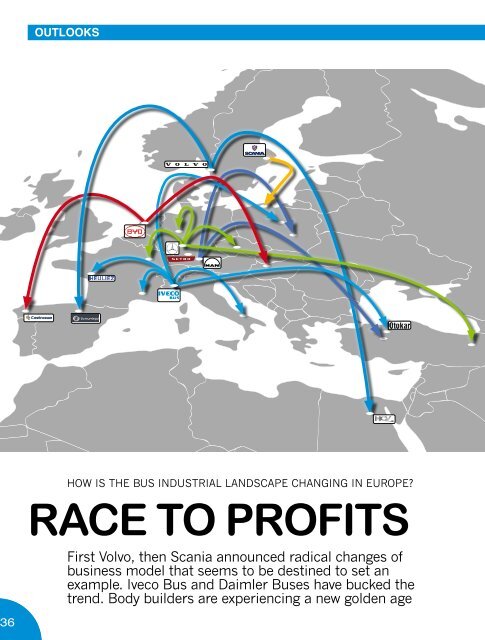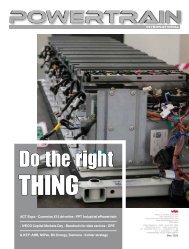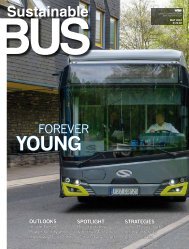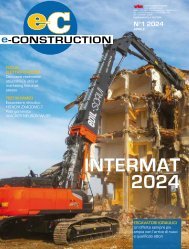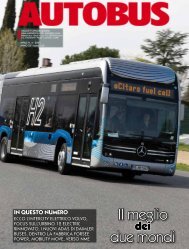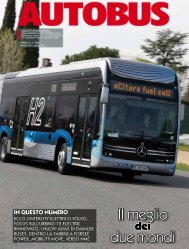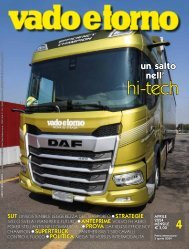2023-09 SUSTAINABLE BUS
A new issue of Sustainable Bus is out today. In this upcoming edition, we’ve curated a diverse and comprehensive range of topics that spotlight the latest developments in the world of sustainable mobility. From cutting-edge technological advancements to market insights and industry transformations, this issue promises to be a captivating exploration of the future of public transportation. What you could fine inside? Well, a market insight will offer you a detailed look at the European e-bus market, providing you with a comprehensive understanding of the mid-2023 results. The leading e-bus market in Europe is still UK: therefore, we focused our attention on that specific market with a report that sums up strategies, focus, goals of the most prominent industry players. A technology spotlight on the delicate topic of batteries, authored by Claudius Jehle, look at battery management and strategies to ensure the smooth and cost-effective operation of electric buses (with a focus on a case study from BVG). Among the pillars of our upcoming issue you’ll find a detailed journey around the European industrial bus&coach landscape. Goal? Providing our readers insights into the changing dynamics among key OEMs in the region. We’ll be then taking you behind the scenes at the Yutong factory in Zhengzhou, that we had the pleasure of visiting in June. Let’s then delve into Iveco Bus’s growing efforts in the zero-emission bus field. Finally, last but not least, a nearly-20-pages comparison between seven 12-meter battery-electric buses, gathered together in Bonn also this year by the German magazine Omnibusspiegel. You’ll find both established players and newcomers side by side: Ebusco 3.0, Hess lighTram 12m, Ikarus 120e, Iveco E-Way, Mercedes eCitaro with new batteries, Otokar e-Kent C, Quantron Cizaris 12 Ev.
A new issue of Sustainable Bus is out today. In this upcoming edition, we’ve curated a diverse and comprehensive range of topics that spotlight the latest developments in the world of sustainable mobility. From cutting-edge technological advancements to market insights and industry transformations, this issue promises to be a captivating exploration of the future of public transportation.
What you could fine inside? Well, a market insight will offer you a detailed look at the European e-bus market, providing you with a comprehensive understanding of the mid-2023 results. The leading e-bus market in Europe is still UK: therefore, we focused our attention on that specific market with a report that sums up strategies, focus, goals of the most prominent industry players.
A technology spotlight on the delicate topic of batteries, authored by Claudius Jehle, look at battery management and strategies to ensure the smooth and cost-effective operation of electric buses (with a focus on a case study from BVG).
Among the pillars of our upcoming issue you’ll find a detailed journey around the European industrial bus&coach landscape. Goal? Providing our readers insights into the changing dynamics among key OEMs in the region.
We’ll be then taking you behind the scenes at the Yutong factory in Zhengzhou, that we had the pleasure of visiting in June. Let’s then delve into Iveco Bus’s growing efforts in the zero-emission bus field.
Finally, last but not least, a nearly-20-pages comparison between seven 12-meter battery-electric buses, gathered together in Bonn also this year by the German magazine Omnibusspiegel. You’ll find both established players and newcomers side by side: Ebusco 3.0, Hess lighTram 12m, Ikarus 120e, Iveco E-Way, Mercedes eCitaro with new batteries, Otokar e-Kent C, Quantron Cizaris 12 Ev.
Create successful ePaper yourself
Turn your PDF publications into a flip-book with our unique Google optimized e-Paper software.
OUTLOOKS<br />
If someone had asked us a couple of<br />
years ago if there was still room for<br />
bodybuilders, we probably would<br />
have answered no. But after the recent<br />
statements from various manufacturers<br />
who intend to downsize or even cease<br />
the production of complete buses, are we<br />
still of this opinion?<br />
Undoubtedly, the ‘electric race’ has shuffled<br />
the cards of a sector that has remained<br />
too tied to old entrepreneurial logics and<br />
dotted with large groups that are economically<br />
uncompetitive and poorly responsive<br />
to market developments. The pandemic<br />
then acted as a catalyst for a process<br />
that was in any case changing the collective<br />
way of moving, especially in the tourism<br />
sector. Furthermore, the appearance of<br />
many new (sometimes improvised) players<br />
is redistributing market shares in the<br />
face of figures that, overall, remain more<br />
or less constant. Finally, an increasing<br />
share has been taken by Chinese groups,<br />
which have never been so present in the<br />
old continent, with a technology already<br />
widely tested and much lower prices. And<br />
what about Turkish brands? Their current<br />
political and economic situation certainly<br />
doesn’t help them, but regardless of this,<br />
they continue to sell several hundred pieces<br />
a year in Europe.<br />
So, is this a sector destined to change?<br />
Yes, and quite a bit. But let’s see in detail<br />
what is happening today and try to understand<br />
where we are going.<br />
res, except for some important contracts<br />
in northern Europe. This maneuver will<br />
logically lead to a further lower income,<br />
which is estimated at around one billion<br />
euros, but from 2025 it will make it possible<br />
to restore competitiveness to one<br />
of the largest automotive groups on our<br />
continent. Production will continue in<br />
Sweden for all the technological parts, as<br />
well as for the chassis to be set up, just as<br />
assistance will be ensured for the entire<br />
fleet already on the road.<br />
Looking at the future, Volvo will strengthen<br />
its partnership with the Egyptian<br />
manufacturer MCV, with which it had<br />
already supplied electric buses in the<br />
United Kingdom, by having the 12- and<br />
18-meter electric 7900 manufactured and<br />
by developing a new project for the intercity<br />
bus. In the field of touring coaches,<br />
Volvo confirmed its collaboration with<br />
coachbuilders, starting with Sunsundegui,<br />
for increasingly customized vehicles that<br />
conform to customer specifications.<br />
SCANIA<br />
idea, which was repeatedly announced<br />
and never really implemented, of developing<br />
platforms common to MAN within<br />
the Traton group was definitely shelved.<br />
On the other hand, the will remains to<br />
follow more paths in alternative tractions<br />
(electric, hybrid, hydrogen, gaseous and<br />
liquid methane) but leaving the task of<br />
‘dressing’ the bus to others, so as to better<br />
accommodate the markets and distribute<br />
the investment costs.<br />
MAN<br />
The ‘electric race’ has<br />
shuffled the cards of a<br />
sector that has remained<br />
too tied to old entrepreneurial<br />
logics and dotted<br />
with large groups that<br />
are economically uncompetitive<br />
and poorly<br />
responsive to market<br />
developments.<br />
HOW IS THE <strong>BUS</strong> INDUSTRIAL LANDSCAPE CHANGING IN EUROPE?<br />
RACE TO PROFITS<br />
First Volvo, then Scania announced radical changes of<br />
business model that seems to be destined to set an<br />
example. Iveco Bus and Daimler Buses have bucked the<br />
trend. Body builders are experiencing a new golden age<br />
VOLVO<br />
I<br />
n March <strong>2023</strong>, the Swedish manufacturer,<br />
one of the first to believe in electric<br />
traction, announced its intention to cease<br />
the production of complete buses in<br />
Europe at the end of the first quarter of<br />
2024, effectively closing the Polish plant<br />
in Wroclaw. The plant will then pass to<br />
Vargas Holding, which will reinstate part<br />
of the 1,500 employees starting from the<br />
end of this year. This decision comes after<br />
years of losses, during which Volvo has<br />
never achieved significant market sha-<br />
Just over a year after the presentation<br />
of the new Interlink, Scania has stated<br />
its intention to stop the production of all<br />
its complete buses, including the Citywide,<br />
foreseeing the drastic downsizing of<br />
the Polish production site and the cutting<br />
of over 800 employees (partly relocated).<br />
The fifth European manufacturer of buses<br />
over 8 tons comes from a three-year period<br />
of constant decline in original vehicles<br />
registered. This is quantifiable in a<br />
minus 35 percent since 2019, compared<br />
to a Scania bus turnover that for 90 percent<br />
is made of vehicles built through<br />
bodywork partnerships all over the world.<br />
A painful but necessary choice, therefore,<br />
to concentrate investments on engines,<br />
chassis and technological parts, making<br />
more and more use of those partners who<br />
over the years have been able to make<br />
the most of robust, reliable and known<br />
everywhere mechanical groups, ensuring<br />
their marketing and assistance. Thus, the<br />
The Bavarian manufacturer has declared<br />
its intention to reduce the production<br />
capacity of the Polish plant in Starachowice,<br />
which is currently the reference<br />
for the entire urban range, in order to transfer<br />
the entire construction process of<br />
electric buses to it, moving all conventional<br />
fuel buses (including methane) in the<br />
recently expanded Turkish plant in Ankara.<br />
All with a cut of about nine hundred<br />
workers, half of whom will be immediately<br />
relocated to the new truck production<br />
unit near Warsaw. In reality, this decision<br />
reduces the overall production capacity of<br />
MAN and Neoplan branded buses, going<br />
from over 7,000 units (although only a<br />
small pre-pandemic share) to just over<br />
5,000, two thirds of which reserved for<br />
the Turkish factory. On the other hand,<br />
the European market has fairly constant<br />
figures and MAN shares fail to increase,<br />
despite an almost completely new range.<br />
636<br />
37


